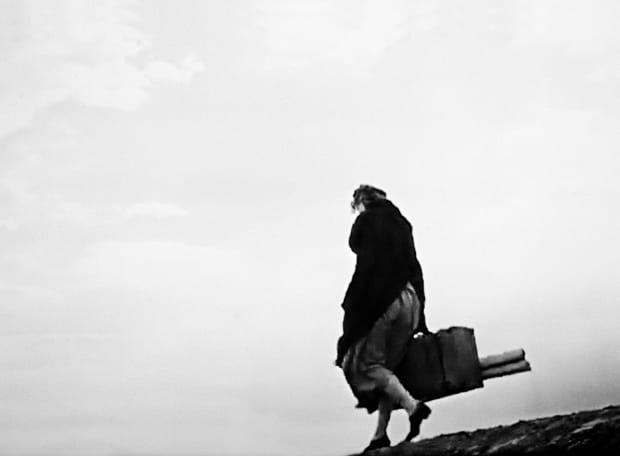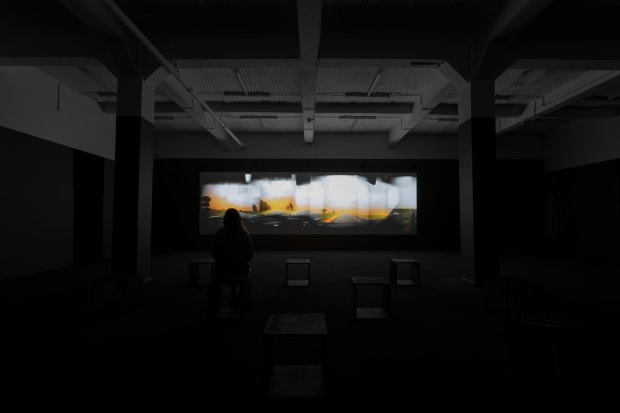-
STEVENSON is pleased to present Being There, an exhibition of new photographs by Jo Ractliffe and a short film, Something this way comes, made in collaboration with composer Philip Miller and filmmaker Catherine Meyburgh. Also on exhibition is an experimental ‘sound book’ where photographs and sound from the film are integrated into the construction and binding of the book itself.
-

-

It is not a story that falls easily and smoothly into sequence. It has been garnered from many sources and from many people. Some of it comes in the form of fragments from men who looked upon strange and violent scenes.
- Paul Gallico, The Snow Goose
Being There came about during the lockdown of 2020 and, like much of Ractliffe’s recent work, looks at what endures in the periphery of loss. Ractliffe says:
'Being There emerged as a query during a conversation with art historian Daniela Montelongo in 2019. The question was how to photograph when one cannot be ‘in place’. Then I was thinking about the constraints of physical disability, but with the outbreak of the Covid-19 pandemic and attendant periods of lockdown, this question took on a different inflection. Like so many people everywhere, my experience of local and international events and my interactions with family, friends, colleagues and students have been mediated by a screen. How then to work photographically when at such a remove from a direct embodied encounter? How to bear witness and speak to desire, loss, horror or violence?
'I have become a thief. This is not entirely new; there have been instances, all the way back to the 1980s even, where, watching a movie, I have paused the frame, got out my camera and taken a photograph - a peculiar compulsion. What’s different here is that almost the entire body of work has its source in documentary and fiction films. Not ‘screengrabs’ or images downloaded from the internet; rather, my camera is set up in front of the screen and I watch and pause and photograph. It’s been quite a strange process: actual photographing but interacting with a virtual world of someone else’s making. And to see what happens when an image is detached from its referent, loses its originating intention and is put into a different configuration. The screen is my portal; I can be anywhere and in any time. Fiction and documentary all mixed up. A world turned inside out.'
-
Scroll right below or click here to view all 51 photographs
-
still #1
-

Ractliffe’s approach to photography is known to be rooted in the long-distance drive, the road as much her medium through which to offer an interpretation of the world as the camera. From her early works in the 1980s to her essays on the consequences of the ‘Border War’ in Angola and South Africa, her photographic projects have consistently entailed lengthy journeys in the landscape. In 2015 Ractliffe sustained an injury that, in her words, ‘altered my life and the way I see things’. In the years since, she has moved away from the narrative sequence of the photo essay, revisiting an earlier interest in juxtaposition and montage. Combining new photographs with previously unpublished images from her archive, Ractliffe’s recent exhibitions, Everything is Everything (2017), Hay tiempo, no hay tiempo (2018) and Signs of Life (2019), have explored the sometimes unexpected associations and meanings that emerge from the seemingly random assemblage of disparate images.
-

The collaborative film Something this way comes finds its title in the utterance of one of the three witches in Macbeth and takes the form of a road movie to the ‘end of the world’. From her archive of Holga plastic camera ‘film-strips’, Ractliffe has assembled a cut-and-paste journey spanning four continents over the course of 30 years, coming to its end at the southernmost tip of Africa. Philip Miller has used both found sound and samples from his archive to create a sonic assemblage. Constructed independently of each other, the visual montage and acoustic fragments come together tangentially, interacting in incongruous ways at times. Editing the film Catherine Meyburgh has composited the photographic strips using a right to left movement, letting the eye rove across and into the image or follow a line without being held back by the frame; she notes how this allows the film to create its own inherent drive - a collage in motion. Something this way comes finds a second iteration in an artist’s book that again combines image and sound, yet with neither as the main medium; rather, they are parallel experiences delivered through the customised form of the book object.
-
Something this way comes - Watch the film
-
Something this way comes – View a video page-through of the book
-

Jo Ractliffe was born in 1961 in Cape Town and lives there. Her first US survey, Jo Ractliffe: Drives, took place at the Art Institute of Chicago in 2020/21. Other recent solo exhibitions include Signs of Life, Stevenson, Cape Town (2019); Hay Tiempo, No Hay Tiempo, Centro Fotográfico Álvarez Bravo, as part of Hacer Noche, Oaxaca (2018); Everything is Everything, Stevenson, Johannesburg (2017); After War, Fondation A Stichting and Galerie de l’erg, Brussels (2015); The Aftermath of Conflict: Jo Ractliffe's Photographs of Angola and South Africa, Metropolitan Museum of Art, New York (2015); Someone Else's Country, Peabody Essex Museum, Salem, Massachusetts (2014); and The Borderlands, Stevenson, Cape Town (2013). Her photo-books include Photographs: 1980s – Now (2020), Signs of Life (2019), Everything is Everything (2017), The Borderlands (2015), As Terras do Fim do Mundo (2010) and Terreno Ocupado (2008).
Jo Ractliffe: Being There
-
STEVENSON is pleased to present Being There, an exhibition of new photographs by Jo Ractliffe and a short film, Something this way comes, made in collaboration with composer Philip Miller and filmmaker Catherine Meyburgh. Also on exhibition is an experimental ‘sound book’ where photographs and sound from the film are integrated into the construction and binding of the book itself.
-

-

-
Scroll right below or click here to view all 51 photographs
-

-

-
Something this way comes - Watch the film
-
Something this way comes – View a video page-through of the book
-









